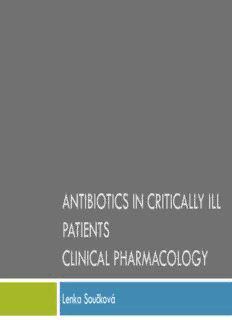
antibiotics in critically ill patients clinical pharmacology PDF
Preview antibiotics in critically ill patients clinical pharmacology
ANTIBIOTICS IN CRITICALLY ILL PATIENTS CLINICAL PHARMACOLOGY Lenka Součková Control of infectious disease MMWR, Achievements in Public Health, 1900-1999: Control of Infectious Diseases, 1999 / 48(29);621-629 Great antibiotic Clear Cure the Pathogen solution patient Is always ATB great? Clear Cure the Pathogen solution patient Critical steps in antibiotic therapy Determine the right time initiating antibiotic therapy - golden hour of sepsis ATB selection the correct dose - dose optimisation - iv to oral switch the correct time interval duration of antibiotic therapy - de escalation inappropriate or redundant antibiotics (dual anaerobic cover etc) Recognize different types of ADRs of individual antibiotics and suitably replace Identify where the use of antibiotics inappropriate / unwanted Normal flora Normal Conditional Pathogen Pathogen Pathogen Microbes that engage in mutual or commensal associations - normal (resident) flora, indigenous flora, microbiota Infection- a condition in which pathogenic microbes penetrate host defenses, enter tissues and multiply Disease – any deviation from health, disruption of a tissue or organ Caused by microbes or their products – infectious disease Symbiosis, natural protection Eradicate all pathogens Innate Resistance to Infection Nonspecific physical, anatomical, and chemical • barriers prevent colonization of the host by most pathogens Lack of these defenses results in susceptibility • to infection and colonization by a pathogen. Anatomic barriers breached (IV’s, foleys, vents etc.) Exposure to virulent pathogens many resistant to multiple antibiotics
Description: